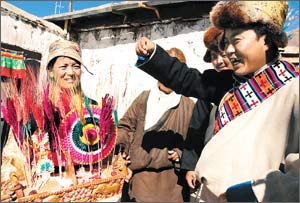|
Tibetan Ethnic Group
( 2005-10-27 )
Tibetans' grand monasteries represent their high architectural level. ThePotala PalaceinLhasais an outstanding example of Tibetan architecture following the style of traditional Tibetan houses, neat and orderly in appearance, practical for protection against wind and cold.
The art of the Tibetan religion has its own unique forms seen inThangka,mural painting, and sculpture. Thangka is a kind ofscroll paintingdrawn on cotton rolls. The stories shown are usually religious.Butter sculpture, which originated several hundred years ago, is a unique Tibetan art. During theLantern Festivalevery year, butter sculptures, based on historical and religious stories and made by the Tibetan Lamas, go on display. The brightness in colors and vivid lifelike figures and flowers amaze many visitors. figures and flowers amaze many visitors.
Tibetan medicine has a history of more than 3,000 years. According to historical records, the first Tibetan king of the Tubo Dynasty already had his personal doctor. Incorporating elements of medical theory and practice from the Han (of the Tang Dynasty) and Indian peoples, Tibetan medicine developed into its own system.
The famous doctor Yutog Yondan Gonbo wrote his masterpiece "Four Volumes of the Tibetan Medicine" in the 7th century. The book, a summary of his experience in different places and countries, including China, India, and Nepal, is of great value even now.
The important festivals of the Tibetans include Tibetan New Year, the Buddha Demonstrating Day, the Sagadawa Festival, the Horserace Gathering and Bathing Festival, and so on.
Recent policy changes have stimulated economic growth in the Tibetan areas, and people's ideas are changing. Tibetans are coming down from the mountains to participate in joint-venture business schemes and exchange programs. They are making their own contribution to the whole of China.
|

